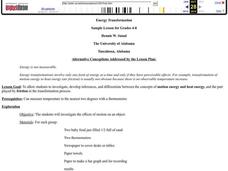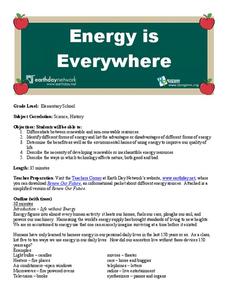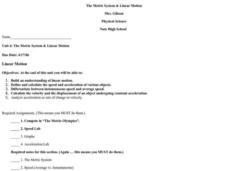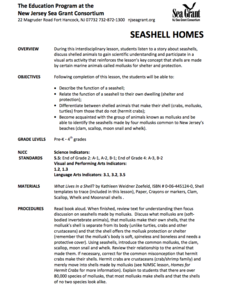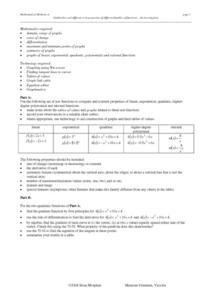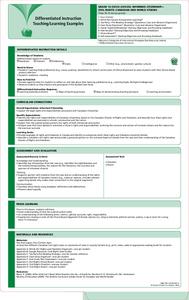Curated OER
Energy Transformation
Students experiment with variety of materials to investigate, develop inferences, and differentiate between concepts of motion energy and heat energy, and the part played by friction in the transformation process.
Curated OER
The Wonderful World of Waves (Wave Basics)
Students define amplitude, wavelength, frequency, and period, calculate period given frequency, and calculate frequency given period, define crest and trough and locate both on diagram of wave, differentiate between latitudinal and...
Curated OER
Energy is Everywhere
Students differentiate between renewable and non-renewable resources and identify the different forms of energy and list the advantages or disadvantages of different forms of energy. They also determine the benefits as well as the...
Curated OER
Linear Motion
Students are able to build an understanding of linear motion. They are able to define and calculate the speed and acceleration of various objects. Students are able to differentiate betweeen instantaneous speed and average speed. They...
Curated OER
Invention/Innovation/Creative Thinking/Opportunities/Ideas
Students, while examining inventions and innovators, identify, differentiate and discuss five Canadian inventors/innovations. After applying creative thinking strategies to a promotional piece, students brainstorm patents.
Curated OER
Let the Campaign Begin
Students differentiate between positive and negative personal attributes and select a fictional character for nomination who personifies the qualities of a good leader. They use the Internet to learn about the election process and write...
Curated OER
Calling All Fruits And Vegetables!
Students differentiate between fruits and vegetables. They identify 20-25 common fruits and vegetables and utilize the Internet to gather and organize information about fruits and vegetables. Afterward, they create a new fruit and...
Curated OER
Where Do They Stand?
In this presidential election worksheet, young scholars research the 2008 presidential candidates and create a booklet of candidate profiles that clearly differentiate each one. They also assume the identity of one of the candidates and...
Curated OER
Euler Encore 1
For this math worksheet, students use Euler's Method to solve differential equations. They are given an equation to graph (y'). Students sketch that equation as well as the related equation (y). They find the area of given rectangles and...
Curated OER
Periodicity (The Periodic Table)
Students investigate the properties of elements and periodicity. In this periodicity lesson plan, students observe a bag of 'elements' which are different fruits and classify them in groups and periods, show the periodic relationships...
Curated OER
Metallic Sounds
Students differentiate between metallic and non-metallic sounds. For this music lesson, students listen to the audio clip of "March" and march in time with the music. Students identify the metallic sounds in the music piece. Students...
Curated OER
Lions and Tigers and Bears - Oh My!
Research animals and develop a non-fiction presentation. Students will complete research on a particular animal and determine the animal's characteristics as well as habitat before choosing a differentiated project to present using the...
Curated OER
Making Waves: A Study of Earthquakes and Tsunami
Students examine plate tectonics and the causative effect of earthquakes. In this tectonics lesson plan students differentiate between the types of energy waves that cause earthquakes and tsunamis and how waves travel at different...
Curated OER
What Is It?
Play the game of Tag and differentiate between plants and animals. Explore the characteristics of plants. Identify the major parts of plants (e.g., seeds, stem, pistil) and describe their basic functions. Compare the requirements of some...
Curated OER
Seashell Homes
Pupils listen to a story about seashells. They discuss shelled animals. Learners describe the function of seashell. Pupils relate the function of a seashell to their own dwelling. They differentiate between shelled animals that make...
Curated OER
Comparing and Collecting Bugs
Students differentiate between insects and non-insects. In this insects lesson, students review the attributes of insects and take a nature walk to look for insect homes. Students use resource books to identify the names of insects seen...
Curated OER
Quotient Rule
Learners differentiate functions. For this differentiating functions lesson, students use the quotient rule to differentiate functions. Learners use the quotient rule to differentiate rational functions such as a quadratic...
Ontario
Reading Graphic Text
Do students really need to be taught how to read cartoons, comic books, and comic strips? Yes. Just as they need to learn how to read other forms of graphic text such as diagrams, photos, timetables, maps, charts, and tables. Young...
Curated OER
Similarities and Differences in Properties of Different Families of Functions - An Investigation
Exploring families of functions allows young scholars compare and contrast properties of functions. Students discuss properties that include symmetry, max and min points, asymptotes, derivatives, etc.
Curated OER
Worksheet 1
In this math worksheet, students give examples of functions that will satisfy given conditions. Students tell the tabulations for a given function. Students use the definition of a derivative to compute the inverse of a function. they...
Curated OER
Worksheet 32 - Antiderivative
In this antiderivative worksheet, students determine the antiderivative by using substitution. They evaluate integrals. This one-page worksheet contains approximately six multi-step problems.
Curated OER
Worksheet One - Definite Integral
In this definite integral worksheet, students use substitution to simplify integrals. They find the values of the upper and lower points and interpret points found on a graph. Students solve this two-page worksheet.
Ontario
Informed Citizenship—Civil Rights
To launch a study of civil rights, class members brainstorm rules and expectations of behaviors at home, in school, in the workplace, and in sports. They then look at civil rights cases and examine the rules embedded in these cases.
EduGAINs
Introduction to Solving Linear Systems
Word problems offer class members an opportunity to learn the concept of solving linear systems using graphs. Individuals choose a problem based upon preferences, break into groups to discuss solution methods and whether there...
Other popular searches
- Cellular Differentiation
- Cell Differentiation
- Implicit Differentiation
- Genetic Differentiation
- Differentiation and Math
- Anti Differentiation
- Differentiation Strategies
- Differentiation Rule
- Differentiation Lesson Plans
- Logarithmic Differentiation
- Differentiation Component
- Writing Differentiation
